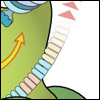Session Overview

|
This session will explain early experiments in Molecular Biology. Outlined are classic experiments by Avery, Griffith, Hershey, and Chase that demonstrated DNA was the hereditary material, background on Chargaff, Watson, Crick, and Franklin and how their discoveries contributed to the discovery of the structure of DNA, and details regarding how the semi-conservative model of DNA replication was shown by Meselson and Stahl. Learning Objectives
|
Session Activities
Lecture Video
Watch the lecture video excerpt
Check Yourself
Question 1
Cells can be fractionated into different chemical components. Both Griffith and Avery found cellular fractions that could transform non-disease causing bacteria into disease causing bacteria. In each case, the transforming fraction contained predominantly which of the following molecules?
Although the fractions were not completely pure, the fractions that had transforming abilities were greatly enriched for nucleic acid, specifically DNA.
Question 2
What functional group is found on the 3’ end of a nucleotide?
Question 3
Which of the following is found in DNA but not in protein?
Session Activities
Lecture Video
Watch the lecture video excerpt
Check Yourself
Question 1
In density gradient centrifugation, which of the following DNA molecules will travel the farthest down the tube?
Session Activities
Practice Problems
Further Study
Suggested topics for further study in an introductory-level Biology textbook
- Classic experiments by Avery, Griffith, and Hershey/Chase
- Chargaff
- Watson, Crick, and Franklin
- Semi-conservative model of DNA replication
Useful Links
- Hershey and Chase Experiment
- Meselson and Stahl Experiment
- “Molecular Structure of Nucleic Acids” (The original Watson and Crick paper)








